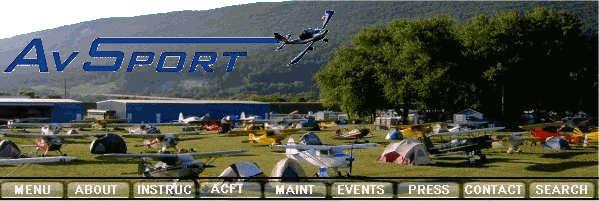
AvSport of Lock Haven -- 353 Proctor Street, Lock Haven PA 17745
Silicon Valley Airport
copyright © 2010 by H. Paul Shuch, All Rights Reserved

Silicon Valley Airport
copyright © 2010 by H. Paul Shuch, All Rights Reserved
I should have known better than to cross my flight instructor. She held the stick, the throttle, the charts, and all the cards.
It seems as though a lifetime has passed (and that certainly holds true for her) since Avalon Eden give me primary instruction in an Aeronca Champ, at Eden Hills Airport in California. Built as a duster strip on barely fertile farmland ten miles East of town, Eden Hills had been in her family since the 1930s. But industrial expansion ultimately leads to urban sprawl, and by the time I started training with Avalon, her airport sported twin paved runways surrounded by homes, schools, and shopping centers. The land was relatively cheap, being near an airport as it was, and there was no Land Use Planning Commission to deny permits. So, it was inevitable that Eden Hills would come under fire.
Fortunately, I was politically well connected, and when the Board of Supervisors moved to close the airport, I got myself appointed Chairman of the County Airport Commission. We on the Commission made our case: the airport had been there for decades, and by building homes next to it, the citizens were accepting all inherent noise, risk, and inconvenience. But then, a string of accidents occurred (none of which, fortunately, caused injuries on the ground, but which served as a reminder of the dangers of living under an approach or departure corridor). Citizens demanded action, and in this case they clearly outnumbered aviators.
AOPA was most helpful in putting together an economic impact report, which showed that, directly and indirectly, the airport generated far more revenue than Avalon had ever imagined. This was around the time that the electronics industry was booming, and semiconductor plants began to replace the prune, apricot, walnut, and grape orchards of the lush Santa Clara Valley. Silicon Valley was being born, both in name and in fact. The local municipal airport had renamed itself International, and wanted rid of General Aviation. Even though Eden Hills was designated a reliever airport, public pressure persisted.
The fiscally conservative Supervisors were hesitant to cut off the steady stream of jobs and tax dollars. So, to save Avalon's beloved airport I hatched a plan: I proposed a simple name change. "Silicon Valley Airport" would convey Eden Hills' new mission, as a growing industry's gateway to the world. Bizjets would abound, prosperity would continue unabated, and the airport's neighbors could either sell at a profit or wait for eminent domain to rear its ugly head.
Avalon was aghast (though not yet a ghost). "Eden Hills has borne my family name for half a century," she pontificated to the County Supervisors. "I'd rather see it closed than renamed." She's being shortsighted, I argued (thus incurring Avalon's further wrath).
Apparently, Avalon had more political clout than I, for not only was the name change proposal dismissed, the airport somehow survived. I promptly forgot the altercation. Avalon, apparently, never did.
Years after her death, long after I had moved East at the behest of my academic career, I ran into Avalon's son Rob at the local airport. He was ferrying a Decathalon for one of the local flight instructors, and recognized me instantly on the ramp. "I know you," Rob bellowed within earshot of everyone on the flight line. "You're the guy who tried to change the name of my mom's airport!"
"I came to praise Eden Hills, not to bury it," I assured him in my best Shakespearian voice. I guess Rob didn't see the big picture. Maybe Avalon hadn't either.
We continued to fly together, Avalon and I, both before her demise and afterward. After that encounter with Rob, I wondered if she still harbored a grudge. So, next time my guardian ghost materialized in the cockpit next to me, I asked her.
"Nah, I let go of that one a lifetime ago," she reassured me. "Things like that are much less important from this side."
"This side?" I inquired.
"Of the line."
"Line?" It was a lame reference to an old joke: the flight surgeon takes away your glasses, and asks what is the smallest line you can read. "Line?" "Yes, line on the chart." "Chart?" "The chart on the wall." "Wall?"
But Avalon was having none of that. "The line that divides the normally aspirated from the turbocharged," she replied, deadly serious.
I wondered what trivial matters I needed to let go of, and if I could do so while still breathing air, and started to ask Avalon. But, in her usual coy fashion, she faded slowly from view, leaving me alone in the plane, to ponder the finer points of mortality and forgiveness.

If you can drive, you can fly!
Copyright © AvSport of Lock Haven, a subsidiary of Microcomm Consulting This page last updated 1 June 2010 |
Top of Page |